
views
Choosing Acrylic Sheets
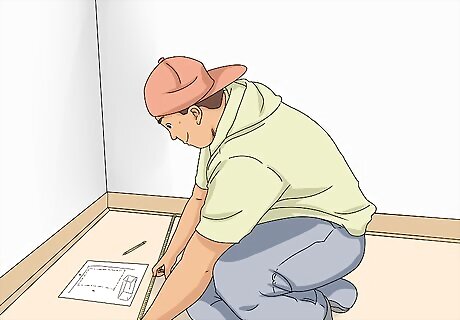
Calculate the right size of your aquarium to house your fish. The ultimate size of your aquarium will depend on a number of important factors, such as the amount of space available in your home and the number and type of fish you’d like to keep. The rule of thumb for determining proper aquarium size is to allocate 1 gallon (3.8 L) of water per 1 inch (2.5 cm) of maximum length for each fish. That might not be accurate depending on the species you have in the aquarium, since two fishes of the same length can have much different body masses, and how much food they consume and how much waste they produce can be very different. When in doubt, talk to a professional about the species you want to add to the aquarium. Make sure you’re also able to allocate enough space for accessories for the aquarium, such as filters, tubing, and cords.
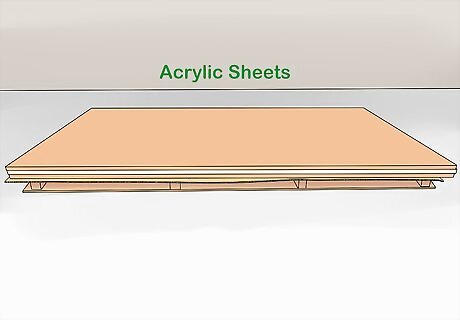
Buy enough acrylic sheets to meet the dimensions of your aquarium. You can buy acrylic from a local plastic shop, or purchase it from an online retailer if need be. For aquariums, most manufacturers recommend using Cell Cast acrylic sheet. Many plastic shops will cut the acrylic for you for free if you tell them the dimensions you need the pieces to be. Consider going this route to save yourself time and energy.
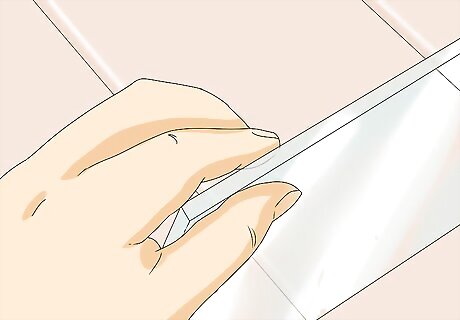
Choose acrylic that’s thick enough based on the aquarium's height. The thickness of the acrylic you’ll need to use will be directly dependent on the dimensions of the aquarium you’re building. For aquariums 1 foot (0.30 m) or less in height, use acrylic that is .25 inches (0.64 cm) thick. For every additional 6 inches (15 cm) in height, make the acrylic an additional .125 inches (0.32 cm) thicker.
Cutting and Sanding the Acrylic
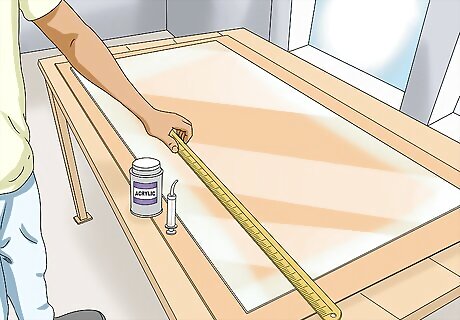
Assemble your materials in a spacious and open workspace. Not only will you need ample workspace to construct your aquarium, but cutting acrylic produces a strong and persistent odor. Consider carrying out this project outside or in a garage with good ventilation. Because your project will involve cementing pieces together and waiting for them to dry before proceeding, make sure your materials are always nearby and that you won’t have to continually leave your workspace to fetch what you need.
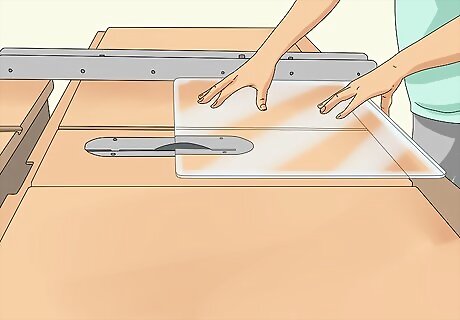
Use a table saw to cut your acrylic into pieces. This is only necessary if you didn’t or couldn’t cut your acrylic at the plastic shop. Use a table saw with closely spaced teeth to avoid chipping the plastic. Measure and mark the acrylic before cutting it, according to the dimensions you determined earlier. Cut your acrylic into 5 pieces: 1 piece to serve as the bottom of the tank; 2 longer pieces to serve as the front and back of the tank; and 2 shorter pieces to serve as the sides. Make sure the front and back pieces are equal to each other in length. Do the same for the 2 shorter pieces.
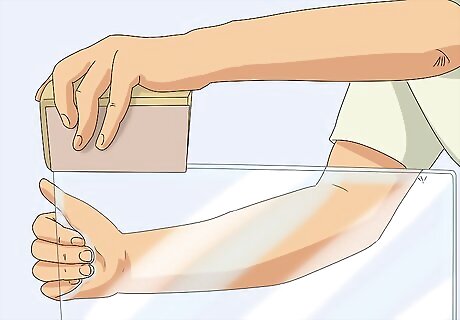
Use sandpaper to smooth out the edges of your acrylic pieces. You’ll need to make sure the edges of your acrylic are smooth and finished before attaching them together. Sanding will also remove unsightly cutting marks. Lay a sheet of 320 grit sandpaper on a flat work surface. Holding the acrylic vertically, run the edge along the sandpaper to achieve the desired effect. In order to keep the acrylic edge flat and square during the sanding process, and to avoid unintentional scuff marks on the plastic, hold it up next to a flat piece of 2x4 lumber while moving it along the sandpaper.
Assembling Your Aquarium
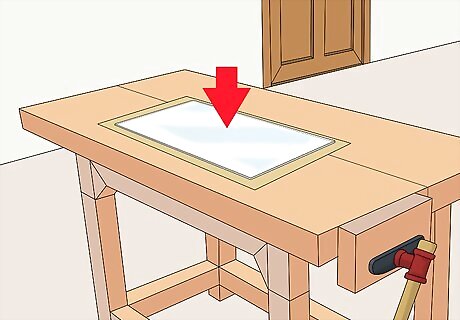
Place your bottom piece on a sturdy, level area. You’ll need to work on a flat surface that will support your acrylic and keep it level for hours at a time. Your aquarium will need to be kept on a stand to prevent the bottom of the tank from bending under the weight of the water. Consider building your aquarium on the surface you intend to ultimately place it in your home, to avoid moving the aquarium after completion.
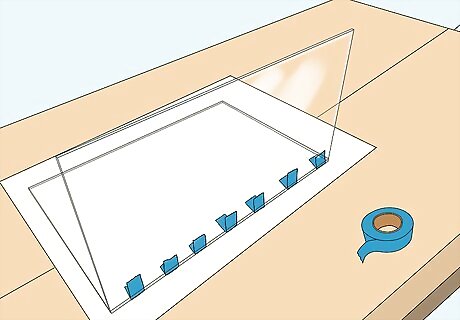
Attach the back piece to the bottom, placing small pins between them. You can use tape or a clamp to attach the pieces together. What’s most important is that you place several pins between the pieces to leave a small amount of space between them. While tape will allow you more dexterity, clamps will prevent the pieces from sliding around on the pins. Use ordinary size-17 ball head pins that are roughly 1.0625 inches (26.99 mm) long in between the acrylic pieces. These can be bought at any home improvement store or mass retail store. Place the pins across the joint between the pieces at even intervals. Place enough to ensure you’ll have enough room to apply cement between the pieces of acrylic.
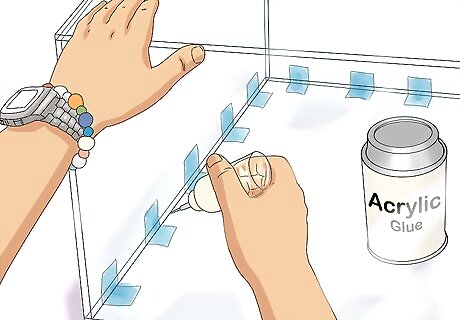
Use acrylic cement to glue the back piece of acrylic to the bottom piece. Remove the pins from between the joints as you apply the cement. Let the cement dry for four hours before proceeding to the next step. Use a syringe filled with acrylic cement to insert the cement into the joint. After the cement has been applied, immediately remove the pins. The cement will then fuse together and begin welding the plastic pieces to one another. The pins should be removed within 30 to 60 seconds of applying the cement.
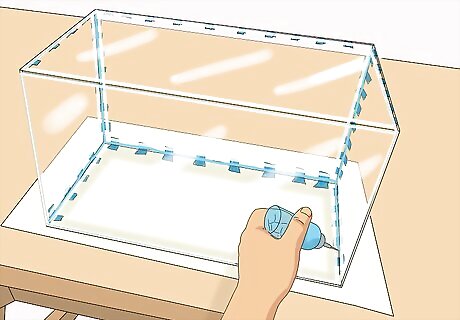
Repeat this process for the front and side pieces of acrylic. Make sure you wait 4 hours before cementing each individual piece of acrylic to yield the best results. After this process the basic structure of your aquarium will be finished. You can also cut and attach a top piece of acrylic to your aquarium, fitted out with holes and openings for a lid, tubing, and other accessories. However, this is not absolutely necessary.
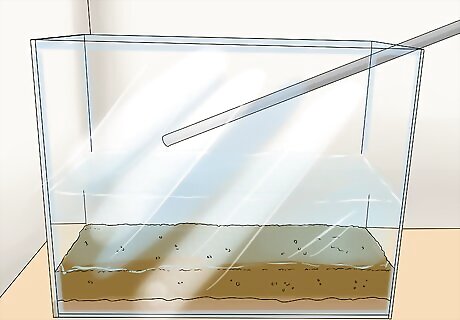
Test your aquarium for structural integrity. You’ll need to make sure there are no gaps in your aquarium that may lead to leaks or cause your aquarium to fall apart. Wait at least 48 hours for the aquarium to cure before testing it. A convenient way to test the aquarium is to place it in a bathtub full of water and lay newspaper at the bottom of the tank. If the newspaper gets wet, you’ll know your aquarium has a leak. You can also test your aquarium by filling it with water, although this method may prove more cumbersome and ultimately damaging to the stand supporting the aquarium if you should find a leak.














Comments
0 comment